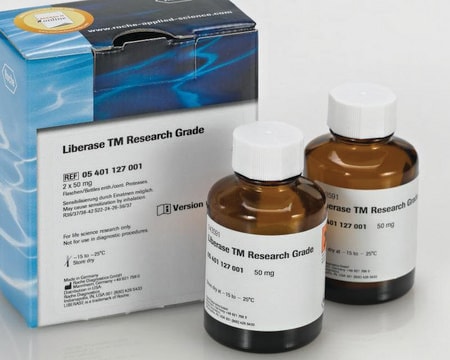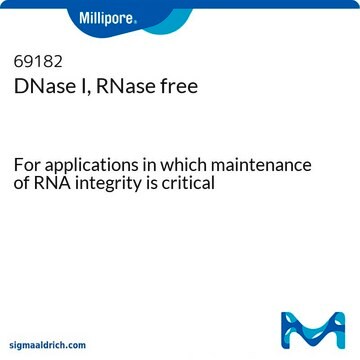04716728001
Roche
DNase I recombinant, RNase-free
from bovine pancreas, expressed in Pichia pastoris
Sign Into View Organizational & Contract Pricing
All Photos(1)
About This Item
Recommended Products
biological source
bovine pancreas
Quality Level
recombinant
expressed in Pichia pastoris
form
solution
mol wt
~39 kDa
packaging
pkg of 10,000 U
manufacturer/tradename
Roche
optimum pH
7.0-8.0
General description
Recombinant DNase I is a DNA-specific endonuclease.The enzyme catalyzes the degradation of both double- and single-stranded DNA randomly by hydrolyzing phosphodiester linkages to DNA, resulting in a mixture of oligo- and mononucleotides. All material used during the production process of DNase I recombinant is non-animal sourced, resulting in an animal-free product.
Contents
Contents
- Recombinant DNase I, RNase-free, 10 U/μl
- Incubation Buffer, 10x concentrated
Specificity
Heat inactivation: One unit DNase I recombinant, RNase-free is heat-inactivated by 10 minutes incubation at 75 °C.
Important Note: Alternatively, DNase I recombinant, RNase-free can be inactivated and removed by phenol extraction according to standard protocols, e.g., Current Protocols in Molecular Biology.
Important Note: Alternatively, DNase I recombinant, RNase-free can be inactivated and removed by phenol extraction according to standard protocols, e.g., Current Protocols in Molecular Biology.
Application
DNase I recombinant, RNase-free may be used to degrade DNA in applications that are sensitive to the presence of RNase. For example, DNase I is frequently used to:
- Remove genomic DNA from RNA preparations prior to RT-PCR
- Isolate DNA-free RNA after in vitro transcription reactions
- Perform nick translations
- Map DNase-sensitive regions in eukaryotic DNA
Features and Benefits
- Eliminates DNA contamination from any RNA sample
- Contains no detectable RNase or protease activity
- Can be heat inactivated, thereby eliminating the need for organic extraction
- Shipped with an optimized incubation buffer, which supports maximum DNase activity
- Produced via an entirely animal-free process, to eliminate any risks associated with animal-derived material
Packaging
1 kit containing 2 components
Quality
Absence of contaminants: Each lot is tested to ensure the absence of RNases and proteases according to the current Quality Control procedures.
Specifications
Glycosylated form
Recombinant DNase I is heterogeneously N-glycosylated, so it appears as two bands in gel electrophoresis.
Divalent ion requirement
DNase I requires divalent cations for maximum activity. The DNA-specific endonuclease is activated by ions such as magnesium ions and is stimulated by calcium ions. Therefore, the enzyme is inhibited by metal chelating agents like EDTA.
Recombinant DNase I is heterogeneously N-glycosylated, so it appears as two bands in gel electrophoresis.
Divalent ion requirement
DNase I requires divalent cations for maximum activity. The DNA-specific endonuclease is activated by ions such as magnesium ions and is stimulated by calcium ions. Therefore, the enzyme is inhibited by metal chelating agents like EDTA.
Unit Definition
One unit is the enzyme activity that effects an absorbance increase of 0.001/minute under assay conditions in 1 ml at 260 nm.
Assay conditions:
Volume activity is determined according to the following assay mixture. 100 μg calf thymus DNA is incubated in 2.5 ml 1x incubation buffer with 40 to 70 units DNase I recombinant, RNase-free at +25 °C. The absorbance increase is measured at 260 nm.
Assay conditions:
Volume activity is determined according to the following assay mixture. 100 μg calf thymus DNA is incubated in 2.5 ml 1x incubation buffer with 40 to 70 units DNase I recombinant, RNase-free at +25 °C. The absorbance increase is measured at 260 nm.
Preparation Note
Activator: Bivalent metal ions
Working solution: Storage Buffer: 20 mM Tris-HCl, 50 mM NaCl, 2 mM CaCl2, 2 mM MgCl2, 1 mM dithioerythritol, 0.1 mg/ml Pefabloc SC, 50% glycerol (v/v), pH 7.6 (at 4 °C).
Incubation Buffer (10x): 400 mM Tris-HCl, 100 mM NaCl, 60 mM MgCl2, 10 mM CaCl2, pH 7.9.
Enzyme Dilution Buffer: 25 mM Tris-HCl, 50% glycerol (v/v), pH 7.6 (at 4 °C).
Working solution: Storage Buffer: 20 mM Tris-HCl, 50 mM NaCl, 2 mM CaCl2, 2 mM MgCl2, 1 mM dithioerythritol, 0.1 mg/ml Pefabloc SC, 50% glycerol (v/v), pH 7.6 (at 4 °C).
Incubation Buffer (10x): 400 mM Tris-HCl, 100 mM NaCl, 60 mM MgCl2, 10 mM CaCl2, pH 7.9.
Enzyme Dilution Buffer: 25 mM Tris-HCl, 50% glycerol (v/v), pH 7.6 (at 4 °C).
Storage and Stability
Store undiluted enzyme solution at -15 to -25°C; storage buffer at 4 °C.
Other Notes
For life science research only. Not for use in diagnostic procedures.
Storage Class Code
12 - Non Combustible Liquids
WGK
WGK 1
Flash Point(F)
does not flash
Flash Point(C)
does not flash
Choose from one of the most recent versions:
Already Own This Product?
Find documentation for the products that you have recently purchased in the Document Library.
Customers Also Viewed
Matthew T Walker et al.
Frontiers in allergy, 2 (2021-08-10)
In animals and humans, offspring of allergic mothers have increased responsiveness to allergen and the allergen-specificity of the offspring can be different than that of the mother. In our preclinical models, the mother's allergic responses influence development of the fetus
Yohey Ogawa et al.
Scientific reports, 11(1), 17340-17340 (2021-09-01)
Vertebrate photoreceptors are categorized into two broad classes, rods and cones, responsible for dim- and bright-light vision, respectively. While many molecular features that distinguish rods and cones are known, gene expression differences among cone subtypes remain poorly understood. Teleost fishes
Kirsten Richter et al.
The Journal of biological chemistry, 295(23), 7849-7864 (2020-04-23)
Activation of the T cell receptor (TCR) results in binding of the adapter protein Nck (noncatalytic region of tyrosine kinase) to the CD3ϵ subunit of the TCR. The interaction was suggested to be important for the amplification of TCR signals
Christina N Cheng et al.
Journal of visualized experiments : JoVE, (89)(89), doi:10-doi:10 (2014-08-01)
The zebrafish embryo is now commonly used for basic and biomedical research to investigate the genetic control of developmental processes and to model congenital abnormalities. During the first day of life, the zebrafish embryo progresses through many developmental stages including
Lucas R Smith et al.
Cellular physiology and biochemistry : international journal of experimental cellular physiology, biochemistry, and pharmacology, 54(3), 333-353 (2020-04-11)
Cell migration and extracellular matrix remodeling underlie normal mammalian development and growth as well as pathologic tumor invasion. Skeletal muscle is no exception, where satellite cell migration replenishes nuclear content in damaged tissue and extracellular matrix reforms during regeneration. A
Articles
Organoid culture products to generate tissue and stem cell derived 3D brain, intestinal, gut, lung and cancer tumor organoid models.
Protocols
DNase I from bovine pancreas is a glycoprotein of Mr 37000. A special procedure is used to remove RNases from the DNase preparation.
Our team of scientists has experience in all areas of research including Life Science, Material Science, Chemical Synthesis, Chromatography, Analytical and many others.
Contact Technical Service








